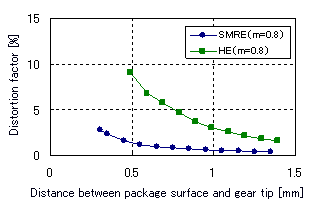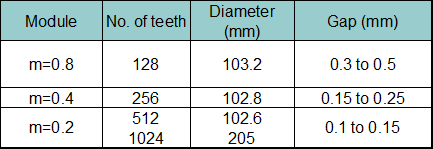Semiconductor Magnetoresistive Elements
-
[Q0379] ・Which has larger output voltage amplitude, semiconductor magnetoresistive element or Hall element? Which has smaller waveform distortion? Are there any other differences?
-
A. ・It depends on the Hall element type, however, a semiconductor magnetoresistive element can obtain larger output voltage amplitude comparing with that of a Hall element. The graph at the right shows a comparison of the distortion factors of the output voltages between semiconductor magnetoresistive element and Hall element when a gear module m = 0.8 is used. The distortion factor of the output voltage from the semiconductor magnetoresistive element is 1/5 or less than that of the Hall element assuming that both has the same gap. In case of the semiconductor magnetoresistive element, the DC component of the output voltage does not depend on the gap, however, in case of the Hall element, it greatly depends on the gap.
 Was it helpful?YesNoThank you We will reflect your opinion on the improvement of the web content.
Was it helpful?YesNoThank you We will reflect your opinion on the improvement of the web content.
-
[Q0380] ・How much resolution can be obtained?
-
A. ・The output voltage from the semiconductor magnetoresistive element has very small waveform distortion and is close to the ideal sine wave. Therefore signals with high resolution can be obtained by electric interpolation. The output voltage corresponding to the electric angle of 360 degrees can be obtained from one cycle (one tooth) of the gear, and the output voltage corresponding to the electric angle of 360 degrees is electrically interpolated to achieve the resolution of 13 to 14 bits. Assuming that the number of gears is 256 (= 8 bits), with the mechanical angle of 360 degrees (one cycle), the resolution of 8 + (13 to 14) = 21 to 22 bits can be obtained.
Was it helpful?YesNoThank you We will reflect your opinion on the improvement of the web content.
-
[Q0381] ・How should the electrical interpolation is done?
-
A. ・We do not provide signal processing ICs for electrical interpolation. however, we can name a few magnet manufacturers.
Was it helpful?YesNoThank you We will reflect your opinion on the improvement of the web content.
-
[Q0382] ・Can we buy a module with magnet?
-
A. ・We do not sell sensor modules with magnet. However, it is possible to provide a sensor module with magnet using MS-0080 or others in SON package for evaluation. Since MS-P082 or others in DIP package are equipped with a magnet case at the back face of the package, it is very easy to assemble it to a sensor module.
Was it helpful?YesNoThank you We will reflect your opinion on the improvement of the web content.
-
[Q0383] ・What kind of bias magnets should we use?
-
A. ・(Material) The widely-used materials for a magnet include a ferrite magnet, neodymium magnet, and samarium-cobalt magnet. Especially, the samarium-cobalt magnet has very small temperature coefficient of the residual magnetic flux density (-0.03%/°C), therefore we recommend this material. Sm2Co17 is the best among the samarium-cobalt magnets. ・(Size) The magnetoresistive elements that we provide are a 4-terminal element in the full bridge structure with four resisters. Two resisters constructing a bridge are placed asymmetrically to a bias magnet. Therefore, to reduce the offset voltage (offset voltage = neutral voltage - Vc/2) with the bias magnet allocated, a certain size of magnet is required. For a samarium-cobalt magnet in MS-0080 element surface, for example, a magnet in size of approx. 5.5 x 4.4 mm is required. The data in our catalogs was measured using a 5.5 x 4.4 x t5.0 mm samarium-cobalt magnet with the magnet and element appressed each other.
Was it helpful?YesNoThank you We will reflect your opinion on the improvement of the web content.
-
[Q0384] ・Where should we buy the bias magnet?
-
A. ・We do not sell bias magnets, however, we can name a few magnet manufacturers.
Was it helpful?YesNoThank you We will reflect your opinion on the improvement of the web content.
-
[Q0385] ・What kind of gears should we use?
-
A. ・(Gear) The gears are stipulated by the following JIS. [JIS B 1701-1:99] Cylindrical gear - Involute gear tooth Part 1 Standard reference rack tooth [JIS B 1701-2:99] Cylindrical gear - Involute gear tooth Part 2 Module ・(Material) Carbon steels for machine structural use (JIS G4051) are suitable. Especially, S25C and S45C are the best of all. The examples of the diameter, number of teeth, and gap of the gear are as follows.
 Was it helpful?YesNoThank you We will reflect your opinion on the improvement of the web content.
Was it helpful?YesNoThank you We will reflect your opinion on the improvement of the web content.
-
[Q0386] ・How much output voltage amplitude is expected? How much temperature characteristics can be obtained?
-
A. ・The output voltage amplitude depends on the gear module, distance between the gear and element, and applied voltage. For the details, click here. For the temperature characteristics of the output voltage amplitude, click here. If a samarium-cobalt magnet is used as the bias magnet, the output voltage amplitude does not almost depend on the temperature at the operational ambient temperature of -40 to 100°C.
Was it helpful?YesNoThank you We will reflect your opinion on the improvement of the web content.
-
[Q0387] ・How much voltage can be applied to the element?
-
A. ・Since the resistance value on the element varies depending on the factors such as the material and size of the bias magnet, distance between the gear and element, the maximum allowable voltage cannot be determined typically. Therefore, it is defined by the allowable loss PD [mW]. Since the allowable loss PD = V * V/R, if the input resistance value Rin in the operational environment is known, it can be determined. Generally, 5 V is applied.
Was it helpful?YesNoThank you We will reflect your opinion on the improvement of the web content.









